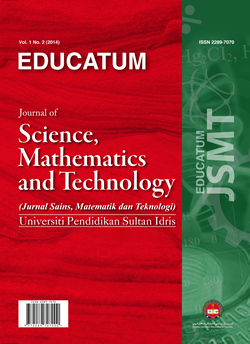Harvesting Energy through Piezoelectric Tiles: A Comparative Study of Wood, Porcelain, and Ceramic Tiles
DOI:
https://doi.org/10.37134/ejsmt.vol10.1.1.2023Keywords:
piezoelectric tiles, wood, porcelain, ceramic, voltage outputsAbstract
This study investigated the feasibility of using piezoelectric tiles in harvesting energy from the footsteps of people. The piezoelectric tiles were made of three materials, namely wood, porcelain, and ceramic tiles, where five piezoelectric plates were attached to each corner and center of individual tiles. A voltmeter was then attached to the piezoelectric tile system to determine the voltage output when people step on the tiles. Study findings revealed that the wood tile produced a mean voltage of 0.711V, the porcelain tile, 0.698V, and the ceramic tile, 1.018V. Analysis of variance results showed that there were significant voltage output differences among the three tiles, and the post-hoc analysis revealed that the voltage outputs of wood and porcelain tiles were comparable with one another, while the voltage output of ceramic tiles was the greatest among the three. The study concluded that the mechanical energy coming from the footsteps could be harvested using the piezoelectric tile, where mechanical energy could be converted into an electrical source. Furthermore, the researchers recommended having a wider variety of sample tiles to see the difference between the tiles and have a wider variety of data that could establish the positive results of this study.
Downloads
References
S. Lekshmi (2010). Importance of electricity. The Hindu [Online]. Available: https://bit.ly/2NF2GQo
BR. Singh, and O. Singh, “Global trends of fossil fuel reserves and climate change in the 21st century,” in Fossil Fuels and the Environment; Rijeka: UbTech Europe, 2012, pp. 167-192
A.V. Herzog, T.E. Lipman, and D.M. Kammen, “Renewable energy sources,” in Encyclopedia of Life Support Systems (EOLSS), 2018
F.Z. Bouzidy, Footsteps: Renewed Tiles, Al Akhawayan in Infrane [Online]. Available https://bit.ly/2NH3Hrr
R. Passmore, and J.V.G.A. Durnin, “Human energy expenditure,” Physiology Review, vol. 35, pp. 801-840, 1955
R.M. Alexander, “Energetics and optimization of human walking and running: The 2000 Raymong Pearl Memorial Lecture,” American Journal of Human Biology, vol. 14, pp. 641-648, 2002
D. Vatansever, E. Siores, and T. Shah, “Alternative resources for renewable energy: Piezoelectric and photovoltaic smart structures,” Global Warming-Impacts and Future Perspective, IntechOpen, 2014
P.S. Dineva, D. Gross, R. Müller, and T. Rangelov, Dynamic Fracture of Piezoelectric Materials, Switzerland: Springer International Publishing, 2014
D.K. Ratnasari, Electrical power generation using piezoelectric ceramic tile prototype design, ResearchGate
E. Fukuda, and I. Yasuda, “On the piezoelectric effect of bone,” Journal of the Physical Society of Japan, vol. 12, no. 10, pp. 1158-1162, 1957
S.R. Pollack, E. Korostoff, W. Starkebaum, and W. Lannicone, “Micro-electrical studies of stress-generated potentials in bone,” Electrical Properties of Bone and Cartilage, New York: Grune & Stratton, 1979
APC International Ltd., The top uses of piezoelectricity in everyday applications [Online]. Available: https://bit.ly/2OmkIfq
D. Kumar, P. Chaturvedi, and N. Jejurikar, “Piezoelectric energy harvester design and power conditioning,” IEE Students’ Conference on Electrical, Electronics and Computer Science, DOI: 10.1109/SCEECS.2014.6804491, 2014
S.J. Hwang, H.J. Jung, J.H. Kim, J.H. Ahn, D. Song, Y. Song, H.L. Lee, S.P. Moon, H. Park, and T.H. Sung, “Designing and manufacturing a piezoelectric tile for harvesting energy from footsteps,” Current Applied Physics, vol. 15, pp. 669-674, 2015
S. Siddapa, and S.A. Ahmed, “Design and analysis of power generating tiles,” International Journal on Mechanical Engineering and Robotics, vol. 4, no. 1, pp. 2321-5747, 2016
A.M. Elhalwagy, M.Y.M. Ghoneem, and M. Elhadidi, “Feasibility study of using piezoelectric energy harvesting floor in buildings’ interior spaces,” Energy Procedia, vol. 115, pp. 114-126, 2017
R.C. Richey, and J.D. Klein, “Development research methods: Creating knowledge from instructional design and development practice,” Journal of Computing in Higher Education, vol. 16, no. 2, pp. 23-38, 2005
Downloads
Published
How to Cite
Issue
Section
License
Copyright (c) 2023 Johann Christian T. Go, Andrew Kim A. Remolino, Joje Mar Perino Sanchez, Kevin E. Paz

This work is licensed under a Creative Commons Attribution-NonCommercial-ShareAlike 4.0 International License.





